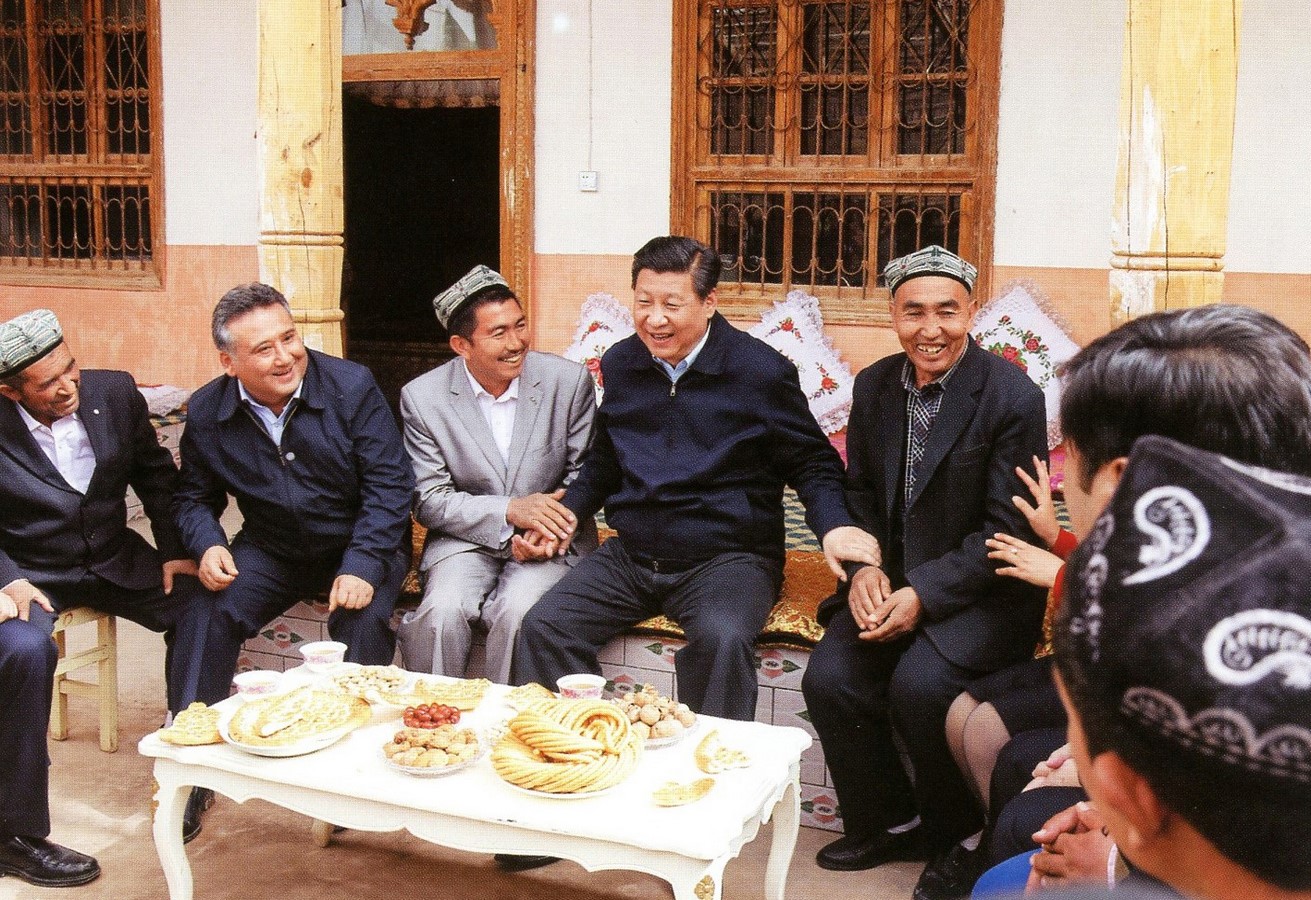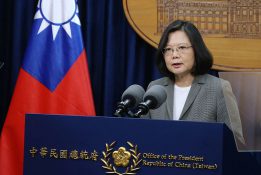Cet article analyse le défi que représente la stabilité des régions à dominante musulmane en Asie Centrale et plus particulièrement du Xinjiang pour le succès du projet de Nouvelles routes de la soie ou « Belt and Road Initiative » (BRI). Sur fond de crainte du séparatisme comme d’un essaimage régional des éléments radicalisés de la minorité Ouigour, Pékin tente selon l’auteur de stimuler l’économie de la province tout en imposant un contrôle répressif, possible laboratoire d’une extension à d’autres provinces.
Les opinions exprimées dans cet article n’engagent pas le CSFRS.
Les références originales de cet article sont : LINCOT Emmanuel, « The BRI, stabilizing factor in the Xinjiang politic? », Asia Focus n°111, IRIS, avril 2019.
Ce texte, ainsi que d’autres publications, peuvent être consultés sur le site de l’IRIS.
During his speech at Astana (2013), which marked the official launch of the Belt and Road Project Initiative project (BRI), Xi Jinping engages in a true profession of faith. It is based on the trust that the Chinese economy will be conditioned by a project of internationally oriented investments in the domain of multibillion-dollar infrastructures; the success of this project is depending not only of the solvency of the borrowing countries but also of the securing of Muslim regions facing a strong instability. To face these challenges, the sustainability of the relations between the centre (China) and its periphery (Central Asia) is a priority. In this, Central Asia is also a laboratory for Chinese diplomacy and economy. China’s growing imports in terms of hydrocarbon (which it will certainly one day, counterbalance by its richness in the domain of rare earth) have engaged its leaders in a cooperation direction reinforced with this part of the world and more particularly with the neighbour Pakistani to connect the port area of Gwadar to the Kashgar oasis in Xinjiang. This northwestern province is, therefore, deeply upset. When it took three days during the past century to connect Beijing to the Kazakhstan border by train, today a few hours are enough. Strategic glaze, a pool of resources, Central Asia offers a depth of field that China has rediscovered thanks to independence (1991) of these former-Soviet Republics. It’s also through Central Asia and in the put in valour of its territories that China collaborates with its Russian partner. Moreover, Moscow and Beijing have sometimes met to denounce the intervention of the US and the NATO in this part of the world. The imposition of Western sanctions has contributed to reinforce the nature of their relationship. Thus, the two powers concluded in 1996 a strategic partnership, then signed a friendship treaty in 2001, and solved the territorial conflicts in 2004. In many ways, Russia and China have not only a common revolutionary past, but they share a number of characteristics in terms of governing. They are constantly trying to thwart the centrifugal forces that drive them. This tendency explains the essential link between their choices of domestic and foreign policy. The nonnegligible asset of Russia is to offer China, in Central Asia or even further, security and stabilization by the use of its armed forces. The Collective Security Treaty Organization (CSTO), created in 2002, but also its nuclear umbrella can provide it even if China keepsaugmenting its own military budget each year. Sign of the time: the Russian and Chinese officials regularly insist on the fact that they have legitimate interests in terms of security which, according to them, neglect to take into account the Western Countries. Ultimately, in which concerns Central Asia, China, and Russia share the same goal: to limit the American presence in Central Asia (closing of the American air bases in Uzbekistan (2005) and Kyrgyzstan in 2014)) and as a natural extension of this one, the Middle East. In fact, it is Beijing that truly initiated the opening up of Central Asia, outstripping at the same time Westerns and Russians [1], by inaugurating a first pipeline from Kazakhstan to China (2005) and then a gas pipeline towards Turkmenistan (2009). These different realizations are all elements that break the monopoly of Russian influence: by creating alternative ways, they permit to these countries to renegotiate more advantageously the bilateral transit agreements with Moscow, or even partially, forgo the Russian intermediary. For now, however, Moscow and Beijing see their interaction in international cases as a growing important element, particularly in central Asia where Russians and Chinese associate to counter the danger represented by Islamist terrorism. It is all the more important to understand that Xinjiang is an essential hub for China’s strategic interests in that this north-western province provides access not only to Central Asia and Russia but also to Kashmir and from northern India. In other words, Xinjiang is the new pivot-ax of the Chinese strategy in Eurasia. In the vast reorganization of the armed forces decided in 2016 by Xi Jinping, everything suggests thinking that the immense West zone (40% of the territory) including the Xinjiang, Tibet, Qinghai, Sichuan, Chongqing, Gansu, Guizhou and Yunnan provinces have become a priority. Near the terrorist hotbeds of Central Asia and Afghanistan, populated by minorities, this new theatre will be in charge of facing the internal threats coming from Tibet and Xinjiang, with the military workforce that will bring together more than one third of the Chinese armed forces.
The new territorial and structural image of the People’s Liberation Army (PLA) thus plans is part of the project of modernization of the Chinese armies, which the conclusion is expected in 2020 [2]. More fundamentally, China’s interest in the Xinjiang refers us to numerous observable facts. The first, of a historical nature, recalls that this western part of China has been reinvested in its strategic depth at the same moment that the Empire – under the Qing Dynasty (1644-1911) – was essentially threatened in its eastern part by western imperialist powers [3]. The second, place an ethnic minority, the Uyghurs, still in majority in the southern oasis of the province, against the overwhelming Han majority. The inequality of their relations is not only of a demographic nature. This is the confrontation between two systems of values. One is referring to Islam. The other has an imperial tradition and a Marxism ideology. In sum, the divergence between each one of these visions of the world puts Xinjiang as the laboratory living thanks to the political contradictions engendered by political rivalries accentuated by the challenges engendered by globalization. These rivalries provoke on both sides a radicalism whose importance is important to recall here.
THE FIGHT AGAINST THE INTERNATIONAL ISLAMISM TERRORISM COUPLED WITH A DEVELOPMENT STRATEGY
Fundamentally, the Chinese authorities have taken stock of the risk of radicalism of the Uygur minority since the collapse of the USSR. The fails of the Soviet neighbour, in the policy of security domain, in the Caucasus or Afghanistan, stay the obsession of the Chinese regime [4]. Let’s recall that at the same title as Russia, China is a power constituted of multiple Muslim minorities [5]. If the Shanghai Cooperation Organization (SCO) permits large cooperation between its members in terms of counter-terrorism with its centre based in Tashkent, the capital city of Uzbekistan, the collapse of Dahesh and its consequences – the comeback of hundreds of jihadist fighters from Dagestan and Uighur to which Russia but also China are directly confronted. In order to face this, China is equipped of a legal arsenal in the form of a law voted on December 27, 2015, by the National People’s Congress permitting to fight against “any form of terrorism” and taking into account the “evolution of this both on the national territory and abroad thanks to both preventive and repressive means”. It is not only about defending the vital interest of its own citizens, but also to participate more in initiatives of multilateral cooperation in the fight against terrorism. That explains the cooperation to the Istanbul Processes or the Global Counterterrorism Forum (GCFT). The engagement of China at the diplomatic level in its efforts to eradicate terrorism was followed by the establishment of a coalition with three of its neighbours among the Muslim States of Central Asia: Pakistan, Afghanistan and Tajikistan.
It is precisely in one of these countries that a certain amount of Uyghur radicals have taken refuge and swear allegiance to terrorist organizations near to Dahesh or Al Qaeda. Generally speaking, Central Asia represents an important territorial part of the caliphate idealized by Dahesh. It is, according to the consecrated formula, the “Wilayat Khorasan” doted of a proper military organization, the El-Khorasan (El-K) and the affiliated but autonomous Islamist military groups (MOI, Ansaroullah, Al-Tawid-wad-Jihad, Iman alBoukhari, Djammat Sabri, Djannat Ochiklari, the Union for the Islamic Jihad, etc.). This denomination can designate the grouping place of Central Asian jihadists on a territory of foreign jihad as well as the action area of Dahesh in Central Asia. Obviously, the means put in place by the Collective Security Treaty Organization (CSTO), and principally by Russia, are, in fact, largely unsuitable to respond to the challenges represented by the multiform threat, especially psychologic, clandestine and mafia, exercised by Dahesh. China seems to want to respond by more ambitious strategic choices. Those consisting of attacking the roots of the evil (traffics, corruption, unemployment, fanaticism, ignorance, unsafety…) by a policy of inclusive and non-exclusive cooperation. In the only Tajikistan, China has imposed itself since the neighbour Xinjiang, and on the strictly economic plan (ongoing reconstruction of the Chinese border road to Murghab, and beyond, delivery more and more regular of merchandises by hundreds of Chinese trucks) considering that the development is for the leaders of Beijing an unavoidable answer to the problem of terrorism. More generally, China has strong relations with all of Central Asia. It is, not only, the first commercial partner of Tajikistan but also of Kyrgyzstan that is only separated from the Xinjiang by the Torougart Pass. Moreover, it is the largest importer of Turkmen products. Besides the Shanghai Cooperation Organization (SCO) which facilitates the multilateral dialogue between its different interlocutors, the Regional Economic Cooperation Program for Central Asia (RECPC) or most recently the Asian Investment Bank for Infrastructures (AIBI) are the two most important institutions facilitating, each, the development of common economic projects. The latter principally relates to a base of investments in the agricultural (irrigation), telecommunications, electricity, and transport sectors. In this global configuration, Kazakhstan and Uzbekistan are not left behind. They constitute evident stowage points to the Belt and Road Initiative (BRI) policy deployed by Beijing since Xinjiang.
Thus, according to a recent article from a governmental agency, “in 2018, almost 450 billion of RMB (were) invested in the autonomous region of Xinjiang. The projects concerned by this investment plan are mainly focusing on the expansion of the Urumqi Airport, the provincial capital, and the modernizing of the rail and road networks of the province. Other projects concern the electric network and the water management in Xinjiang. These new investments reflect China’s desire to transform Xinjiang into an important hub for Central Asia and Pakistan. The Xinjiang province is at the centre of the “Belt and Road” initiative. At the launch of the Belt and Road Initiative (BRI) in 2013, the Xinjiang and Fujian were designated as the key provinces of the BRI. By building new transport infrastructures in Xinjiang, China hopes to boost its exchanges with its western neighbour. This modernizing could also reduce the time of transport by railway between Europe and China. China hopes to economically open these provinces of the West after having succeeded in developing its coastline. The economic imbalance between those two regions is a major problem for China. The development of the new Silk Roads could permit to reduce this imbalance” [6]. By consequences, the connection between China and Central Asia gives access – through all the Eurasia continent – to a market of dozens of countries and millions of potential consumers.
Following the past road by the Gansu and Lanzhou, Urumqui and Khorgas in Xinjiang, the Belt and Road Initiative Project (BRI) keeps going from the North of Iran, then the East of Iraq, Syria, Turkey, and Bosporus, before turning to the North-West, in direction of Bulgaria, Romania, Czech Republic, and Germany. After Duisburg, one of the German directions served by the railway coming from China and Russia with Leipzig and Hamburg, it then turns through Rotterdam to after turn back to the South-East to Venice where it joins the maritime road. Obviously, the access to the European Union depends for China on securing and developing Central Asia. Some statistical data can permit to realize the extraordinary dynamism of Xinjiang on the economic plan. Even if these data are official, they are corroborated by observations made in the field; in particular the one about the development of the infrastructures. Thus, in a little less than a decade, China has arranged a highway system linking now Beijing to Xinjiang on 2768 kilometres. Today, it is the world longest highway system crossing a desert. Another reality: in 2017, 700 trains of merchandizing connected Urumqi to Europe. They were 1400 the past year. With a growth rate of 7.6 %, the growth rate of Xinjiang is officially the highest point of the national average. Finally, despite the troubles the regions encounter, the number of tourists (Han mostly) grows on average of 32.4%. They were 100 million in 2017 to visit the province and to spend 182 billion yuan [7].
PEACE FACTOR OR WORTH LABORATORY?
However, in a context of reciprocal mistrust between the Han and Uighur communities, each effort to stimulate the economy, as beneficial as they could be, are inevitably perceived as colonialist. Atypical Han intellectual and of them all, the pretty rare one to have shown interest without any preconception, to the Uighur, Wang Lixiong [8], in a work from a little over ten years ago, had shown that the Han monopolized the markets share of Xinjiang [9]. Some important real estate developments have been realized by companies established, furthermore on the coast, regardless of the Uighur interests. Recent surveys have also demonstrated that the American companies are participating in this general dynamism [10] by focusing on an almost exclusive relationship with their Han interlocutors of the Xinjiang. Moreover, this racial discrimination is encouraged by the system which is mostly Han. The mandarin is imposed to the most at the expense of the Uighur language. Truly, the Uighur society doesn’t find its place in the “great development of the West” (Xibu dakaifa). On the contrary, it is each year, more and more repressed. Thus, Beijing increases considerably the intrusive monitoring systems in the Xinjiang province. Methods of surveillance that the president Xi Jinping has deployed and which could be used as a test for the metropolitan centres as Beijing, Shanghai, and Guangzhou, have been developed there. “In this spirit, adds the reporter Alexander Trevor, it is more than likely that the militarization of the Xinjiang by China will become an essential element of its strategy of governance elsewhere, while China represses by the digital monitoring at home to help protect its influence abroad” [11].
The fact remains that the Chinese government targets the athletes, the artists (of which the musician Sanibar Tursun), the intellectuals (such as Abduweli Ayup and many others [12]), and the public personalities [13] to control the speaking and more generally, its methods seem to reconnect with the totalitarian practices of another age in order to control the whole population through terror [14]. An “abnormal” beard, the denial of drinking alcohol or eat pork, are parts of the external signs of “possible extremism” that can result in an arrest and detention [15]. The humiliations are systematic as the interference of the authorities in the organization of funeral rituals [16]. The surveillance of the territory has been considerably reinforced. A searcher in cybersecurity recently detected a vulnerability permitting to access a colossal database of a Chinese facial recognition company [17]. This information was confirmed by an investigation of the newspaper Le Monde. “Up to one million people are or have been detained in centres of political reeducation of the region, say the experts mentioned by the United Nations (UN) and the organizations of protection of the human rights” [18]. The Chinese authorities, in turn, talk about “centres of professional formation” or “de-radicalization” camps. To this day, they are 180 [19] giving rise to brainwashing and torture sessions on an unprecedented scale on every detained people [20].
According to Aina Shormanbayeva, advocate and director of the Kazak Federation of Human Rights, some of these detainees might be Kazaks [21], even if under the pressure of Kazakhstan, an important partner of China for the New Silk Roads Project, several dozen of them would have been released [22]. Abuses committed against other Muslim minorities, including the Hui, have also occurred [23]. They participate in a growing Islamophobia, including in the neighbour provinces like the Ningxia [24]. Thus, less than two years ago, Chinese web surfers had engaged a virulent debate online accusing the power to treat too well its Muslim minority. At the heart of this controversy, the Halal food and, initial cause of the viral effervescence of the net, the lack of non-halal restaurants in the Ningxia universities. Simple identity reflex or, at the reverse, radicalism: in each case, the Chinese government reacts strongly against any manifestation it considers to be synonymous of creeping Islamism [25]. This preoccupation is not totally unfounded as the influence of the Wahhabism in the regions traditionally foreign to it, was finally proved [26]. In response, it explains the limitless obsession of the monitoring, the grid-monitoring and the put to the norms of the Muslim communities, most particularly Uighur. Thereby, the NGO “Human Right Watch” mentions a large-scale use of “generalized collect of the DNA from every inhabitant under the pretext of free medical exams” [27]. The Xinjiang is the contact point of China with what the regime perceives as a double threat held by a separatist movement and the hostility of radical Islam. The conjunctions of the two which could, according to the State Security, generate an internal terrorist risk whose actions could expand out of the province. This risk explains the security clenching and gives to the Xinjiang the statute of a laboratory in terms of generalized monitoring of the populations. It seems to, now, be operational for the whole territory [28]. Obviously, the image of China, its regime, the BRI Project that Xi Jinping hold is thus, seriously tarnished. By thinking of buying social peace thanks only to economic development, Beijing seems to obtain the reverse effect to what it was expecting. The association of the reprisal policy led by the State-Party to the Xinjiang’s New Silk Roads project also divides the international community.
BRI AND XINJIANG: A LONG-LASTING TOPIC
The Xinjiang both from the point of view of its economic and political choices represent a much-contrasted force field in the appreciation and commentary which it ultimately generates at the international level. From a significant way, the Saudi Crown Prince Mohammed Ben Salman whose image has seriously been deteriorated since the Kashoggi [29] affair hopes to increase the cooperation with his main trading partner thanks, especially, to the New Silk Roads. He will not say anything about the fate of the Uyghur Muslims during his State visit to Beijing, the past February 22. “Giving-giving”, as the Chinese diplomacy likes to repeat: from one side a 10 billion dollars contract firmed with the State of Saudi oil company Armaco for the building of a Refinery Complex in China. From the other side, the Chinese leader of the telecoms Huawei promises to invest 20 million dollars each year in Saudi Arabia, in particular in research centres, with 10,000 jobs to the key. It is about reinforcing the commercial exchanges with the first commercial partner of the kingdom, but also the cultural, and scientific links with the setting up of prices to congratulating the countries’ personalities [30]. The attitude of the Turkish authorities is the opposite [31]. On February 25, the government spokesperson declared: “the Human rights violations must not be covered by a suit of fight against terrorism” [32]. The announcement of the closure of the general consulate of China in Izmir occurs in an unprecedented context of crisis between Ankara and Beijing [33]. The repression led by Beijing against the Uighur keeps going even further than China’s frontiers, as in France where intimidations and threats of retaliation against families of the nationals established abroad are more and more frequents [34].
However, the systematical recording of information of the populations provokes reactions as in the USA; the involvement of the company Thermo Fisher in the large scale sequencing of the human genome is debated [35]. Therefore, it is still the general indifference that prevails and more particularly in Muslim countries [36]. The public indignation of British Muslims is without a doubt an exception, at least in the Western Countries, which confirms the rule. Michelle Bachelet, United Nations High Commissioner for Human Rights, asked Beijing at the beginning of this year for “a direct access to the region to verify the worrying information” reported by the NGO and the independent medias [37]). Pious hope because, it seems like the Chinese authorities are remaining to anyone who will listen, a revolution, of an economic type moreover, is never – to paraphrase Mao Zedong – “a gala dinner”.
References


































